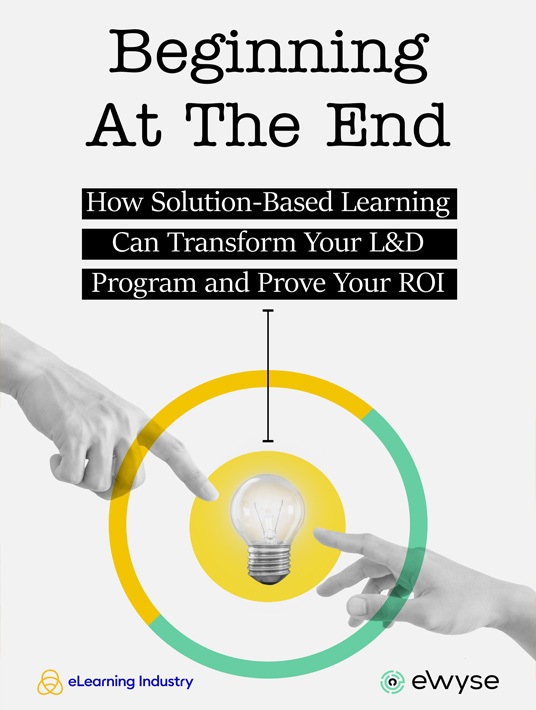Disclose Gaps And Measure ROI With Solution-Based Learning
A key component of the sometimes arduous process of getting internal buy-in is ensuring that eLearning will give you the best return on your investment. Fortunately, solution-based learning takes the headache out of proving Return On Investment (ROI) because it allows you to disclose pain points and start with the problem so that you're able to measure success every step of the way and mitigate financial risks, which we'll explore in this article.

Prove Training ROI With Solution-Based Learning
1. Define Clear Objectives
Solution-based learning centers on clear and measurable objectives. As we've already highlighted, setting parameters for success is an integral part of the process. You can't set off on your eLearning design journey without a destination, after all. Creating this criterion gives you the opportunity to align training with your KPIs and business goals. For example, after careful analysis, you discover that the root of the problem is passive versus active and collaborative learning experiences. You implement solution-based learning and notice an increase in employee engagement, a stronger team dynamic, and lower turnover. These are all things that can be measured based on the parameters you've developed to prove ROI.
2. Take A Problem-First Approach
Ultimately, solution-based learning aims to find specific solutions to a problem with long-term results. This ensures that the process of designing, delivering, and supporting lessons that cater to learners' needs is worth every cent. So, rather than solving a performance issue more broadly, you can create a strategy that identifies underlying problems to prevent them from reoccurring. You're also able to go back to a previous step to focus on objectives that haven't been achieved instead of brushing your L&D issues under the rug and continuing to pay for the upkeep of courses that aren't truly effective.
3. Adapt To Emerging Needs
New industry regulations, workplace processes, and job responsibilities are just a few of the wrenches that may be thrown into the L&D works. Solution-based learning allows you to adapt to emerging needs and challenges because there are criteria you can revisit to ensure that your eLearning initiatives are still relevant and results-driven. For instance, new job roles call for a revamped upskilling and reskilling program. In many respects, solution-based learning takes a more iterative approach because you can rewind to other stages in the process to concentrate on initiatives that might fuel business growth and innovation, which translates into higher ROI.
4. Dig Deeper To Identify Hidden Gaps
Many traditional eLearning development methods start with a broad goal and expectations. You expect the learner to be able to perform a task or cultivate a certain soft skill by the time they complete the course. But this doesn't account for hidden gaps and roadblocks that might stand in the way of those achievements. Solution-based learning enables you to delve deeper into the issues to eliminate any hurdles that negatively impact your ROI. Let's say that the primary outcome is to reduce work-related conflicts. Thus, you're going to launch an interpersonal skills and conflict resolution training initiative. However, there may be other factors in play that you need to consider. Maybe you also need to assess your company culture or determine if some members of the team are contributing to a toxic work environment. As we've said before, sometimes eLearning isn't the answer, and solution-based learning opens up all available options.
5. Rely On External Expertise
One of the most common misconceptions about bringing in an outsourcing partner is that it's more costly than tackling the task in-house. The truth is that hiring an eLearning agency can actually help you prove ROI by conducting a thorough needs analysis and offering their unique expertise. They know how to connect L&D initiatives to real-world outcomes in order to determine where the problem lies so that you can invest in initiatives that make the biggest impact. For instance, you've invested a significant amount of resources into your compliance certification program, but there are still occasional policy breaches that may lead to fines or penalties. An eLearning consulting agency can use various evaluation methods to figure out how to reinforce knowledge and facilitate practical application to improve your ROI and avoid unnecessary risks. These are quantifiable elements that show a link between training and on-the-job performance.
Conclusion
Proving ROI can be a daunting task when more qualitative metrics are involved, such as skills development. However, even these can be measured using employee feedback, surveys, assessments, and customer satisfaction scores. In fact, eWyse can help you create evaluation criteria to track employee growth and workplace performance so that you can connect the dots between eLearning and business objectives.
Download the eBook Beginning At The End: How Solution-Based Learning Can Transform Your L&D Program And Prove Your ROI today to discover how you can leverage the solution-based approach to achieve your objectives and make your eLearning development process more problem-centered. You can also listen to the eLearning Unscripted podcast today to delve deeper into the solution-based strategy and all the benefits it has to offer.

